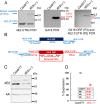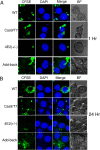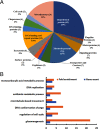Distinct features of the Leishmania cap-binding protein LeishIF4E2 revealed by CRISPR-Cas9 mediated hemizygous deletion
- PMID: 33760809
- PMCID: PMC8021392
- DOI: 10.1371/journal.pntd.0008352
Distinct features of the Leishmania cap-binding protein LeishIF4E2 revealed by CRISPR-Cas9 mediated hemizygous deletion
Abstract
Leishmania parasites cycle between sand-fly vectors and mammalian hosts adapting to alternating environments by stage-differentiation accompanied by changes in the proteome profiles. Translation regulation plays a central role in driving the differential program of gene expression since control of gene regulation in Leishmania is mostly post-transcriptional. The Leishmania genome encodes six eIF4E paralogs, some of which bind a dedicated eIF4G candidate, and each eIF4E is assumed to have specific functions with perhaps some overlaps. However, LeishIF4E2 does not bind any known eIF4G ortholog and was previously shown to comigrate with the polysomal fractions of sucrose gradients in contrast to the other initiation factors that usually comigrate with pre-initiation and initiation complexes. Here we deleted one of the two LeishIF4E2 gene copies using the CRISPR-Cas9 methodology. The deletion caused severe alterations in the morphology of the mutant cells that became round, small, and equipped with a very short flagellum that did not protrude from its pocket. Reduced expression of LeishIF4E2 had no global effect on translation and growth, unlike other LeishIF4Es; however, there was a change in the proteome profile of the LeishIF4E2(+/-) cells. Upregulated proteins were related mainly to general metabolic processes including enzymes involved in fatty acid metabolism, DNA repair and replication, signaling, and cellular motor activity. The downregulated proteins included flagellar rod and cytoskeletal proteins, as well as surface antigens involved in virulence. Moreover, the LeishIF4E2(+/-) cells were impaired in their ability to infect cultured macrophages. Overall, LeishIF4E2 does not behave like a general translation factor and its function remains elusive. Our results also suggest that the individual LeishIF4Es perform unique functions.
Conflict of interest statement
The authors have declared that no competing interests exist.
Figures







Similar articles
-
LeishIF4E1 Deletion Affects the Promastigote Proteome, Morphology, and Infectivity.mSphere. 2019 Nov 13;4(6):e00625-19. doi: 10.1128/mSphere.00625-19. mSphere. 2019. PMID: 31722993 Free PMC article.
-
Deletion of a Single LeishIF4E-3 Allele by the CRISPR-Cas9 System Alters Cell Morphology and Infectivity of Leishmania.mSphere. 2019 Sep 4;4(5):e00450-19. doi: 10.1128/mSphere.00450-19. mSphere. 2019. PMID: 31484740 Free PMC article.
-
LeishIF4E2 is a cap-binding protein that plays a role in Leishmania cell cycle progression.FASEB J. 2024 Jan;38(1):e23367. doi: 10.1096/fj.202301665R. FASEB J. 2024. PMID: 38095329
-
Unorthodox Mechanisms to Initiate Translation Open Novel Paths for Gene Expression.J Mol Biol. 2020 Dec 4;432(24):166702. doi: 10.1016/j.jmb.2020.10.035. Epub 2020 Nov 7. J Mol Biol. 2020. PMID: 33166539 Review.
-
eIF4E and Interactors from Unicellular Eukaryotes.Int J Mol Sci. 2020 Mar 21;21(6):2170. doi: 10.3390/ijms21062170. Int J Mol Sci. 2020. PMID: 32245232 Free PMC article. Review.
Cited by
-
LeishIF4E-5 Is a Promastigote-Specific Cap-Binding Protein in Leishmania.Int J Mol Sci. 2021 Apr 12;22(8):3979. doi: 10.3390/ijms22083979. Int J Mol Sci. 2021. PMID: 33921489 Free PMC article.
-
The EIF4E1-4EIP cap-binding complex of Trypanosoma brucei interacts with the terminal uridylyl transferase TUT3.PLoS One. 2021 Nov 22;16(11):e0258903. doi: 10.1371/journal.pone.0258903. eCollection 2021. PLoS One. 2021. PMID: 34807934 Free PMC article.
-
Characterization of an Atypical eIF4E Ortholog in Leishmania, LeishIF4E-6.Int J Mol Sci. 2021 Nov 24;22(23):12720. doi: 10.3390/ijms222312720. Int J Mol Sci. 2021. PMID: 34884522 Free PMC article.
-
Finding Correlations Between mRNA and Protein Levels in Leishmania Development: Is There a Discrepancy?Front Cell Infect Microbiol. 2022 Jul 12;12:852902. doi: 10.3389/fcimb.2022.852902. eCollection 2022. Front Cell Infect Microbiol. 2022. PMID: 35903202 Free PMC article. Review.
-
Analysis of the Leishmania mexicana promastigote cell cycle using imaging flow cytometry provides new insights into cell cycle flexibility and events of short duration.PLoS One. 2024 Oct 3;19(10):e0311367. doi: 10.1371/journal.pone.0311367. eCollection 2024. PLoS One. 2024. PMID: 39361666 Free PMC article.
References
Publication types
MeSH terms
Substances
LinkOut - more resources
Full Text Sources
Other Literature Sources
Miscellaneous

